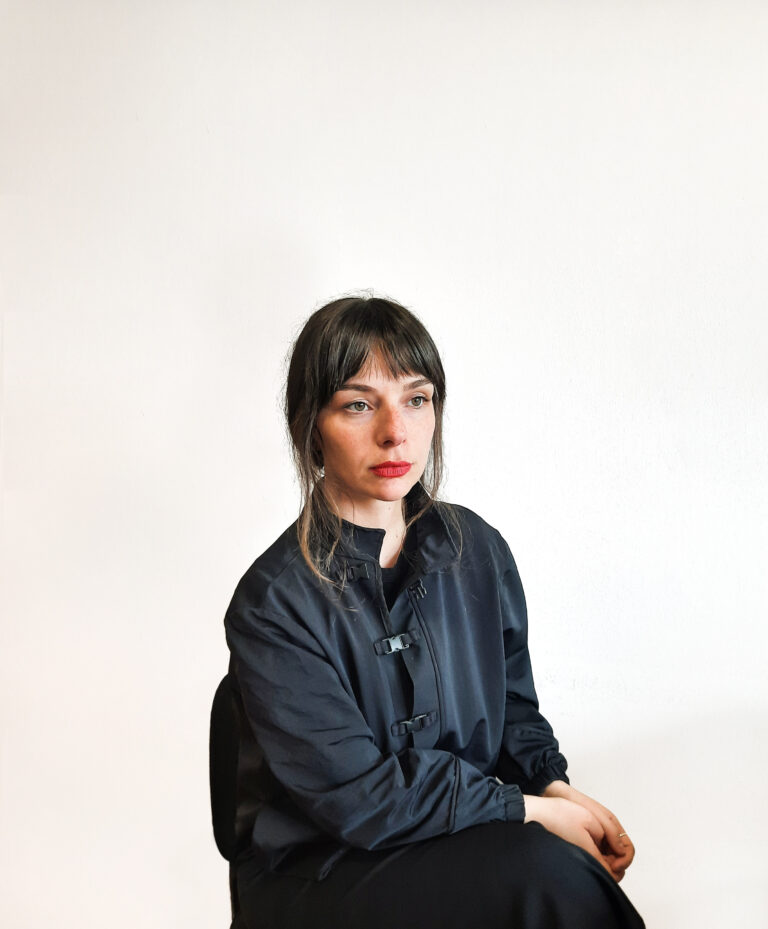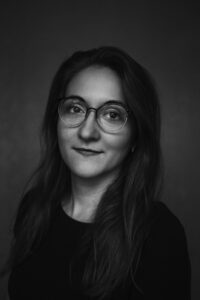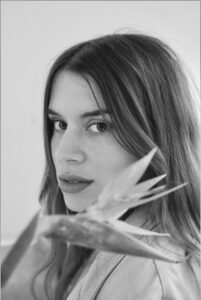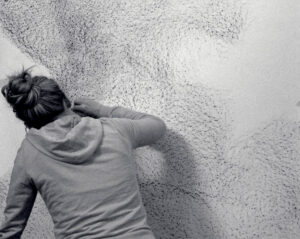Doruntina Kastrati

— born in 1991, Kosovo — is a Prishtina-based visual artist. Her work has been on display in numerous national and international exhibitions in the past six years. In 2017, she produced her solo exhibition Red Landscape in collaboration with Stacion – Center for Contemporary Art in Pristina. In 2014, Kastrati earned a Young Visual Artist Award and, in 2016, was the winner of the first edition of the Hajde! Foundation. She was a resident artist at the International Studio & Curatorial Program in Brooklyn, New York, United States, 2015, Art House in Shkodër, Albania, 2018, and Initiator in Athens, Greece, 2018. Her work has been shown in a solo exhibition at the at ChertLüdde/Bungalow, Berlin; Life, Without Buildings at gta Hönggerberg, Zurich; Not Fully Human, Not Human at All at Kunstverein in Hamburg; When it left, death didn’t even close our eyes at KADIST, Paris; Temel at Hessel Museum of Art, New York; Bigger than Myself. Heroic Voices from ex-Yugoslavia at MAXXI Museum, Rome.
Living in a patriarchal society such as ours, thinking and experiencing oneself as a woman has been a challenge in itself over the last few years. At a young age, a woman has the face of a grandmother and mother, as someone who must be a “mother” to also be a woman. Their activities were closely linked with domestic work and their value was measured by their ability to take care of the house and the family. Meanwhile, the man, apart from being the “father figure” also had the designated role of ensuring the welfare of all family members. These were more or less the expectations defined by society, within our small household in the city of Prizren.
Almost all small townhouses in Prizren bear the sweat of my grandfather who was a construction worker. I often feel as if I see his face in the red bricked walls, within the hard concrete columns holding those townhouses together. Growing up in a house and neighborhood mainly inhabited by construction workers, has informed my views towards the social and political situation of my country, and beyond that, has profoundly influenced my artistic formation as well. My work, Red Landscape is a work of art which somewhat visualizes that experience. Some skills as a sculptor I acquired from observing the workers in my neighborhood. The sculptural pieces in the works Ring the Bells my Land12 and Long Walk were created together with them. Sculptures amongst ruined tiles often give the impression of a “post-human condition,” born out of an apocalypse, and for others they may come across as beings exhausted and alienated by the need for survival.
Prompted by a close relationship with the past, but treating it as an issue of the present, I naturally began researching and interviewing construction workers throughout the streets of Prishtina, Ferizaj, Shtime, Fushë Kosovë. I began meeting and filming construction workers who experienced accidents in the workplace, mainly while constructing highways which connect Kosovo with Albania and North Macedonia. From this research, I produced Public Heroes and Secrets3456, which is also a line from my favorite poem “Godzilla en México”7 by Roberto Bolaño. The piece, among others, speaks to the romanticization of the working class for nationalistic narratives, thereby using their bodies and allowing them to think that by sacrificing themselves for the “road of the nation,”, they would be hailed as “heroes of the nation.” This piece was preceded by an exhibition in the Kosovo National Museum in July 2020, together with a short documentary film8910 and a series of sculptures.
Prior to this research, Untitled111213 came a piece I carried out together with the workers of Titan company, at the Archeological Museum of Elefsina, a city near Athens, Titan is the only concrete factory left in Greece following the economic crisis of 2009, an event that hit Greece hard. For the first time in the history of its institution, the Elefsina Archeological Museum provided their consent to hold a concrete sculpture produced in collaboration with the workers of the Titan factory. Among the debris of marble artifacts, which in themselves held hundreds of years of history, Untitled stood as a monumental sculpture, which in its structure had only metal rods, pure concrete and an unspoken history of the local workers. For me, the opportunity to unveil these individual stories is the true power of art.
The role of artists, in general, I think is to not take things for granted, reminding oneself constantly that the visible reality often hides something unstable within, or to quote James Baldwin, “There is nothing stable under heaven.”14 I see art and artists as all-powerful in changes they can bring to society, especially in a post-war society such as ours, undergoing a period of transition. The language of art for me is a universal language, which manages to communicate beyond the mere verbal, beyond ethnicity and belonging, and deal with societal and political issues, making artwork more accessible and able to be interpreted in different contexts, thus enabling new perspectives.
Bearing in mind the multiple burdens that women carry, being a woman means that you belong to one of the most vulnerable groups in Kosovo society. Patriarchalism, as a system installed in every pore of society, inevitably appears in the world of art as well. Starting from the unequal access to opportunities that female artists have compared to male artists, unpaid domestic labor and beyond, the burden of having to give birth to children and raise them, the need to choose between “family” and career due to the lack of opportunity to realize both. When we talk about women, we cannot overlook another particular group of women, non-white women, who are not equally represented in art but live amongst us. Gender is not the only dimension that shapes the experiences of women artists in a patriarchal society, here intersects class, race, sexual orientation and many other socio-political identities.
1Image: Doruntina Kastrati, RING THE BELLS MY LAND, 2022, Manifesta 14, Pristina, Kosovo. Photography Majlinda Hoxha. Courtesy of the artist.2Image: Doruntina Kastrati, RING THE BELLS MY LAND, 2022, Manifesta 14, Pristina, Kosovo. Photography Majlinda Hoxha. Courtesy of the artist.
3Image: Doruntina Kastrati, PUBLIC HEROES AND SECRETS, Photography: Genta Pallaska. Courtesy of the artist.
4Image: Doruntina Kastrati, PUBLIC HEROES AND SECRETS, Photography: Genta Pallaska. Courtesy of the artist.
5Image: Doruntina Kastrati, PUBLIC HEROES AND SECRETS, Photography: Genta Pallaska. Courtesy of the artist.
6Image: Doruntina Kastrati, PUBLIC HEROES AND SECRETS, Photography: Genta Pallaska. Courtesy of the artist.
7Godzilla en México, de Roberto Bolaño, https://libreriodelaplata.com/godzilla-en-mexico-de-roberto-bolano/.
8Image: Photo Still: Doruntina Kastrati, When it left, death didn’t even close our eyes, 2020, short documentary. Courtesy of the artist.
9Image: Photo Still: Doruntina Kastrati, When it left, death didn’t even close our eyes, 2020, short documentary. Courtesy of the artist.
10Image: Photo Still: Doruntina Kastrati, When it left, death didn’t even close our eyes, 2020, short documentary. Courtesy of the artist.
11Image: Exhibition views: Doruntina Kastrati, Untitled, Archaeological Museum of Eleusis, 2018, Greece. Photography: Stathis Mamalakis. Courtesy of the artist.
12Image: Exhibition views: Doruntina Kastrati, Untitled, Archaeological Museum of Eleusis, 2018, Greece. Photography: Stathis Mamalakis. Courtesy of the artist.
13Image: Exhibition views: Doruntina Kastrati, Untitled, Archaeological Museum of Eleusis, 2018, Greece. Photography: Stathis Mamalakis. Courtesy of the artist.
14Baldwin, James, THE CREATIVE PROCESS, 1962. Creative America, Ridge Press[29/07/2022]. See: https://openspaceofdemocracy.files.wordpress.com/2017/01/baldwin-creative-process.pdf.
— e lindur në vitin 1991, Kosovë — është një artiste vizuele me bazë në Prishtinë. Puna e saj është shfaqur në ekspozita të shumta kombëtare dhe ndërkombëtare në gjashtë vitet e fundit. Në vitin 2017, ajo prodhoi ekspozitën e saj personale “Peisazhi i Kuq” në bashkëpunim me Stacion – Qendrën për Art Bashkëkohor në Prishtinë. Në vitin 2014, Kastrati fitoi një Çmim të Artistit Vizual të Ri dhe, në vitin 2016, ishte fituesi i edicionit të parë të “Come on!” Fondacionit. Ajo ishte një artiste rezidente në Programin Ndërkombëtar të Studiove dhe Kuratorëve (Brooklyn, New York, Shtetet e Bashkuara, 2015), Art House (Shkodër, Shqipëri, 2018) dhe Iniciator (Athinë, Greqi, 2018). Puna e saj është shfaqur në një ekspozitë personale në ChertLüdde/Bungalow, Berlin; Life, Without Buildings në gta Hönggerberg, Cyrih; Not Human at All, në Kunstverein në Hamburg; When it left, death didn’t even close our eyes, në KADIST, Paris; Temel, në Muzeun e Artit Hessel, Nju Jork; Bigger than Myself. Heroic Voices from ex-Yugoslavia, në Muzeun MAXXI, Romë.
Të jetuarit në një shoqëri patriarkale si kjo e jona, të menduarit dhe përjetuarit veten si grua ndër vite ka pësuar përshkallëzimin e vet. Në moshën e re, gruaja ka pasë fytyrën e gjyshes dhe nanës, si dikush që doemos duhet të jetë “nanë” që të quhet grua. Aktiviteti i tyre ka qenë ngushtë i lidhur më punët e shtëpisë dhe vlera e tyre është matur me aftësinë e të kujdesurit për shtëpinë dhe familjen. Ndërkohë që burri përveç figurës së “babës” ka pasë rolin e caktuar që të siguroj jetesën e të gjithë anëtarëve të familjes. Këto pak a shumë kanë qenë dhe detyrat, të përcaktuara nga shoqëria, mbrenda shtëpisë së vogël në qytetin e Prizrenit.
Shtëpitë e vogla të qytetit kanë pothuajse të gjithë djersën e gjyshit, si një punëtor krahu, saqë shpesh më duket se e shoh figurën e tij në bllokat e kuq të mureve, dhe në betonin e fortë të shtyllave që mbajnë shtëpitë e qytetit. Të rritesh në një shtëpi dhe lagje që kryesisht ishte e banuar me punëtorë krahu sigurisht që ka ndikuar edhe në qëndrimet e mija karshi situatës shoqërore dhe politike të vendit, dhe përtej saj ka ndikuar thellë edhe në forminin tim artistik. Në praktikën time artistike Red Landscape është punë që vizualizon deri diku këtë eksperiencë. Shkathtësitë si skulptore i kam marrë nga punëtorët e lagjes. Madje, skulpturat e punës Ring the Bells my Land12 dhe Long Walk janë të punuar bashkë me ta. Skulpturat në mesin e tullave të prishura shpesh të japin përshtypjen e një “post-human condition” (gjendje post-njerëzimi), të lindura pas një apokalipsi, për disa të tjerë janë qenie të lodhura, të tjetërsuara nga nevoja për mbijetesë.
E nxitur nga një marrëdhënie e ngushtë me të kaluarën, por duke trajtuar çështje të kohës së sotme, natyrshëm kam filluar hulumtimin dhe intervistimin e punëtorëve të krahut nëpër rrugët e Prishtinës, Ferizajit, Shtimës, Fushë Kosovës, e duke takuar e filmuar punëtorë të cilët janë aksidentuar gjatë punës, kryesisht gjatë punimit të autostradave që lidhin Kosovën me Shqipërinë dhe Maqedoninë e Veriut. Nga i gjithë ky hulumtim kam krijuar punën Public Heroes and Secrets 3456 që njëkohësisht është një varg nga poezia ime e preferuar e Roberto Bolaños, Godzilla en México6. Puna ndër tjerash flet për romantizimin që i bëhet klasës puntore për narrativa nacionaliste, kështu duke i shfrytëzuar trupat e tyre e duke i bërë të mendojnë që të rënit duke ndërtuar “Rrugën e Kombit” do t’i bënte ata të quheshin “heronj të kombit”. Kësaj pune i ka paraprirë një ekspozitë në Muzeun Kombëtar të Kosovës në korrikun e vitit 2020, bashkë me një film dokumentar të metrazhit të shkurtër8910 dhe një seri skulpturash.
Para këtij hulumtimi Untitled111213, është punë që unë e kam realizuar në Muzeun Arkeologjik të Elefsinës, qytet në Greqi afër Athinës, së bashku punëtorë fabrikës së betonit Titan, e vetmja që kishte mbetur pa kapitulluar pas krizës ekonomike që kishte goditur Greqinë në fund të vitit 2009. Për herë të parë historikisht Muzeu Arkeologjik i Elefsinës pranoi të sjellë një skulpturë betoni të ndërtuar nga unë në bashkëpunim me punëtorët e fabrikës Titan. Midis artefakteve e copave të mermerit që në vete kishin histori qindra vjeçare, Untitled qëndronte si skulpturë monumentale që në strukturë kishte vetëm shufra metalike, beton të pastër dhe një histori të pafolur më herët të punëtorëve lokal. Mundësia që m’u dha për të shpalosur këto histori individuale, për mua shpesh herë edhe përbën fuqinë e artit.
Roli i artistëve në përgjithësi mendoj se është të mos i pranojnë gjërat si të mirëqena, gjithmonë duke i kujtuar vetes që realiteti i dukshëm fshehë diçka jo stabile dhe jo të qëndrueshme, apo siç thotë Baldwin, “Nuk ka asgjë të qëndrueshme nën qiell”14. Andaj, artin dhe artistët i shoh si fuqiplotë në ndryshimet që mund të sjellin në shoqëri, e sidomos në shoqëri tranzicionale të pas luftës si kjo e jona. Gjuha e artit për mua është gjuhë universale që arrinë të komunikoj përtej verbales, përtej etnisë e përkatësisë dhe të trajtuarit e çështjeve politike dhe sociale, dhe kjo e bën veprat të lexohet dhe interpretohet në kontekste të ndryshme, kështu duke mundësuar perspektiva të reja.
Të qenunit grua në Kosovë do të thotë se i takon një ndër grupeve më të cenuara në shoqëri, kjo duke marrë parasysh barrën e shumëfishtë që gratë e kanë në shoqërinë kosovare. Mendësia patriarkale shpërfaqet në çdo pore të shoqërisë, domosdoshmërisht vie në pah edhe në botën e artit. Duke filluar nga mundësitë e pabarbarta që gratë artiste kanë karshi burrave artistë, punës së papaguar në shtëpi e përtej, barrës së lindjes e rritjes së fëmijëve, nevojës së zgjedhjes midis familjes dhe karrierës në pamundësi për t’i aktualizuar të dyjat. Kur flasim për gratë, nuk mund të anashkalojmë edhe një grup të caktuar të grave artiste, që nuk janë gra “të bardha” të cilat nuk gëzojnë priviligje të asnji lloji në sferën e artit dhe ato janë në mesin tonë. Pra, gjinia shpesh nuk është përcaktues i vetëm që formëson përvojën e një artisteje në shoqëri patriarkale, aty ndërthuret edhe klasa, raca, orientimi seksual dhe pozicioni politiko – ekonomik.
1Imazh: Doruntina Kastrati, RING THE BELLS MY LAND, 2022, Manifesta 14, Prishtinë, Kosovë. Fotografia Majlinda Hoxha.2Imazh: Doruntina Kastrati, RING THE BELLS MY LAND, 2022, Manifesta 14, Prishtinë, Kosovë. Fotografia Majlinda Hoxha.
3Imazh: Doruntina Kastrati, PUBLIC HEROES AND SECRETS. Fotografia Genta Pallaska.
4Imazh: Doruntina Kastrati, PUBLIC HEROES AND SECRETS. Fotografia Genta Pallaska.
5Imazh: Doruntina Kastrati, PUBLIC HEROES AND SECRETS. Fotografia Genta Pallaska.
6Imazh: Doruntina Kastrati, PUBLIC HEROES AND SECRETS. Fotografia Genta Pallaska.
7Godzilla en México, de Roberto Bolaño, https://libreriodelaplata.com/godzilla-en-mexico-de-roberto-bolano/.
8Imazh prej dokumentarit të shkurtër: Doruntina Kastrati, “When it left, death didn’t even close our eyes”, 2020.
9Imazh prej dokumentarit të shkurtër: Doruntina Kastrati, “When it left, death didn’t even close our eyes”, 2020.
10Imazh prej dokumentarit të shkurtër: Doruntina Kastrati, “When it left, death didn’t even close our eyes”, 2020.
11Imazh: Doruntina Kastrati, Untitled, 2018, pamje nga ekspozita në Muzeun Arkeologjik të Eleusis, Greqi. Fotografia: Stathis Mamalakis.
12Imazh: Doruntina Kastrati, Untitled, 2018, pamje nga ekspozita në Muzeun Arkeologjik të Eleusis, Greqi. Fotografia: Stathis Mamalakis.
13Imazh: Doruntina Kastrati, Untitled, 2018, pamje nga ekspozita në Muzeun Arkeologjik të Eleusis, Greqi. Fotografia: Stathis Mamalakis.
14Baldwin, James, THE CREATIVE PROCESS, 1962. Creative America, Ridge Press.[29/07/2022]. Link: https://openspaceofdemocracy.files.wordpress.com/2017/01/baldwin-creative-process.pdf.


